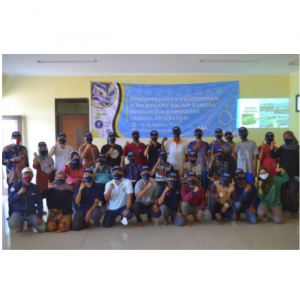
Biofilm in Aquaculture
| Thu, 26 Aug 2021 - 14:20
The application of biofilm will certainly contribute to reducing costs and making aquaculture an environmentally friendly activity.
What is Biofilm?
A biofilm is a collection of microbial cells bound to a surface and enclosed in a predominantly polysaccharide substrate. It can form on many types of surfaces, including living tissue, equipment, instruments or natural aquatic systems. Various organisms such as algae, bacteria, protozoa, arthropods, etc. can be observed in this biofilm collection.
Biofilm in Aquaculture
The structure of biofilm in aquatic environments depends on the nature of the substrate, the availability of nutrients, the light and the activities of the organisms in it. Organisms in biofilm are microscopic in size and have high nutritional value. This is considered a good quality, sustainable protein source (23-30%) and is readily available in all sizes of farmed aquatic species.
Microalgae and heterotrophic bacteria in biofilm are a good source of energy to support immunity enhancement, growth stimulation, bioactivity and digestive stimulation for livestock. The presence of biofilm in culture systems also helps to improve water quality because of the absorption of ammonium and phosphate and the production of more oxygen.
Read more: Microbial Community of Probiotic-Treated Shrimp Survivors Put to AHPND Challenge Test
1. In terms of Nutrition
Biofilm acts as a supplementary feed source, providing essential nutrients such as unsaturated fatty acids (PUFAs), sterols, amino acids, vitamins and pigments to help animals grow better. Moreover, the organic substrate of the biofilm also has many significant effects, as a safe haven for fish and shrimp, reducing the stress effects when rearing at high densities.
The protein content in it can vary from 23 to 30%, and the lipid content ranges from 2-9%. The content and composition of the microbial community really greatly affects the nutritional quality of the biofilm. The use of biofilm will certainly contribute to reducing costs and making aquaculture an environmentally friendly activity.
2. In Terms of environmental Treatment
Biofilm is a suitable means of removing nitrogenous compounds from aqueous media, especially ammonia and nitrite, which are highly toxic. Biofilm is essential in maintaining water quality as nitrifying bacteria and microalgae will assimilate the ammonia, allowing the circulation of nutrients in the culture medium. Furthermore, the biofilm will also absorb phosphate and produce oxygen for the culture systems.
Read more: Shrimp Farming by Semi-Biofloc Technology
Stages of Biofilm Formation
The addition of artificial media for microbial growth will help biofilm have better quality. biofilm can be divided into four stages of formation:
a. Adsorption of soluble organic compounds, i.e. macromolecules, and attachment to surfaces (is a spontaneous physicochemical process).
b. Bacterial settlement - after the bacteria there begin to produce extracellular macromolecules (EPS), which protects them against predators.
c. Invasion of protozoa, mainly protozoa, microalgae and cyanobacteria.
d. Settlement of eukaryotic multicellular organisms.
Biofilm and Biofloc
Similar to biofilm, bioflocs include algae, fungi, bacteria, and flagellates, which bind to other microorganisms that adhere to organic substrates, but the limitation is that bioflocs cannot form when the flow is too fast. In this technology, microorganisms will maintain water quality and serve as food for the producing organisms.
On the other hand, biofilm forms on all surfaces, even ultrapure water, so it is not unusual for a biofilm to form even on biofloc. The beneficial bacteria in biofloc reside on the surface of a thin but complex biofilm. This biofilm can be very persistent and virtually impossible to remove.
Read more: Relationship Between Vannamei Size and Consumption of Bioflocs
The Reverse Side of Biofilm
With an objective view, biofilm not only benefits but also has many harmful effects that have been studied in aquaculture. If the composition of this biofilm is dominated by pathogenic bacteria, this is a major threat to farmed fish and shrimp.
There have been many studies on biofilm of Vibrio bacteria in shrimp farming systems; Flavobacterium columnare, A. hydrophila and Edwardsiella form thick biofilm in catfish ponds.
With high thickness and adhesion, it is difficult to remove these unwanted biofilm from culture systems. The economic loss is huge, when this biofilm is the cause of prolonged epidemics in aquaculture. In order for biofilm not to become “destructors” in aquaculture, it is important to know how to control them so that they become “protective walls”. Check regularly to know the exact density and composition of bacteria present in the water.
Periodic disinfection is also a way to avoid the formation of these pests in the aquatic environment. And should also create conditions, add substrates for beneficial biofilm to grow and promote their full benefits.
Source: Tepbac.com






















